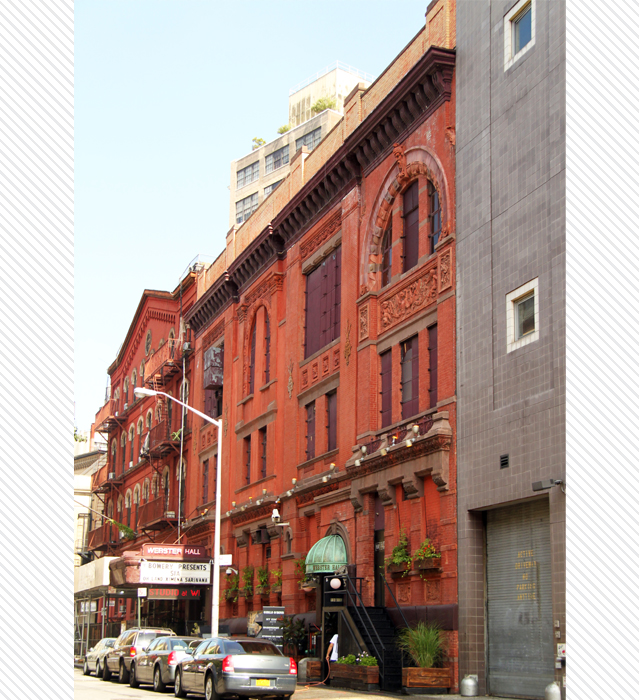- Home
- East Village Block Finder
- Guided Tours
- African American History
- Astor Tenements
- CBJ Snyder Schools
- Churches
- Dry Dock District Tour
- Historic East 10th Street
- Individual Landmarks
- Kleindeutschland
- LGBTQ Sites
- Little Ukraine
- Loisaida Tour
- Music Venues
- Off-Off Broadway Theatres
- Places that Matter
- Punk Rock
- Squats of the East Village
- Synagogues
- Yiddish Rialto
- Glossary
125 East 11th Street; 119-125 East 11 Street | Block : 556-2 | Lot #68
- Building Date : 1886-87
- Original Use : Commercial
- Original Owner : Charles Goldstein
- Original Architect : Charles Rentz
Description & Building Alterations
Webster Hall was designed in 1886 by architect Charles Rentz in the Queen Anne style and topped with an elaborate mansard roof. Six years later in 1892, Rentz was hired to design an addition to the building, occupying the site of 125 East 11th Street and designed in a Renaissance Revival style using the same materials as the original building. Throughout the early twentieth century the building was plagued by fires, which occurred in 1902, 1911, 1930, 1938, and 1949. The original mansard roof was likely lost in one these fires.
In its early years, Webster Hall was a center of leftist, anarchist, and union political activity, and gathering place for the city’s working class, whether it was for union rallies or for evening entertainment. In 1888, the Brooklyn Eagle described Webster Hall as “a big, bare, dingy place, where all the year round discontented men meet to discuss their wrongs and sympathize with one another, and where secret societies and political organizations, labor unions and similar associations make a business of pleasure. It is a grimy neighborhood, where the rattle of trade continues all day and leaves poverty to toss itself to sleep at nightfall.” The hall hosted notable figures including labor leader Samuel Gompers, who visited the Hall for a meeting of striking brewery workers in 1888, and social activists like Emma Goldman and Dorothy Day. The founding convention of the Amalgamated Clothing Workers of America also took place at the hall in December 1914.
By the 1910s and 1920s, it became famous for its masquerade balls, following the success of a 1913 fundraiser for the socialist magazine The Masses. The parties, which attracted the bohemians of the Village and beyond, grew more and more outlandish–and the costumes, skimpier and skimpier. Although Prohibition could have killed the momentum of the parties, in fact, it had the opposite effect. As liquor consumption was driven underground, Webster Hall became a speakeasy, and the legends of the parties grew. Gay and lesbian Villagers first attended the parties of accepting organizations like the Liberal Club, but by the mid-1920s were putting together dances and celebrations of their own at the hall. These celebrations were able to continue without harassment, as long as the police were paid off properly. When Prohibition was finally repealed, a large ball called the “Return of John Barleycorn,” was thrown on New Year’s Eve to celebrate.
By the end of the 1950s, RCA converted the building into their East Coast recording studio and called it the “Webster Hall Studios.” Elvis Presley, Perry Como, Tony Bennett, Frank Sinatra, Harry Belafonte, and Julie Andrews all sang at the studios, and several musicals, including Hello, Dolly! and Fiddler on the Roof, were also recorded here.
Webster Hall reemerged on May 1, 1980 as The Ritz nightclub, and until its relocation in 1986, it was a leading venue for punk and rock shows in New York City. The roster of Ritz performers included Madonna, Iggy Pop, Danzig, Tina Turner, Eric Clapton, Prince, Sting, Guns N’ Roses, KISS, among many others. MTV made its debut at the Ritz and would go onto present Live at the Ritz on a seasonal basis. In 1990 the building was purchased by the Ballinger Family from Toronto, and returned the Webster Hall name to the reborn dance club and concert venue which remains today.
As real estate development pressure grew exponentially in the East Village during the 2000s, and historic sites like St. Ann’s church just one block north were lost to out-of-scale developments, Village Preservation and others saw the need to protect the scale and character of many of the East Village’s unique historic structures. In the summer of 2007 Village Preservation supplied the Landmarks Preservation Commission with extensive research on the history of Webster Hall, and urged the LPC to landmark the site. Shortly thereafter the LPC commissioners voted to consider the building for landmark designation and in spring of 2008 the building was officially designated a New York City landmark, recognizing its extraordinary role in the cultural development of the Village.
Block : 556-2 / Lot : 68 / Building Date : 1886 / Original Owner : Charles Goldstein / Original Use : Commercial / Original Architect : Charles Rentz


Do you know this building? Please share your own stories or photos of this building here!